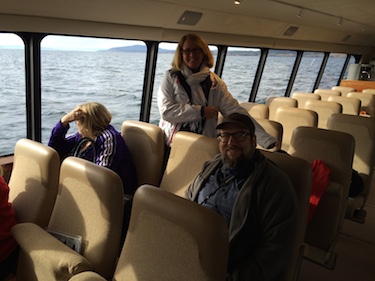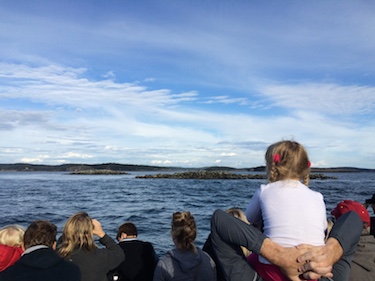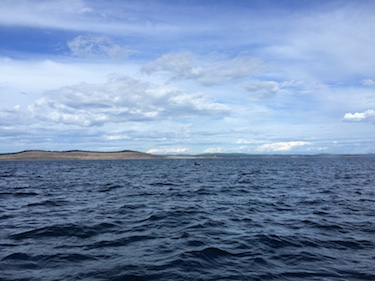Whale watching in the Puget Sound is a must-do when you visit Seattle, but it’s an exercise in expectation setting. While you’ll be guaranteed to see whales (or your money back!), if you’re expecting them to be jumping over your boat in graceful arcs, or “posing” for photos by treading water Sea World style, then you’re going to be disappointed.
I shouldn’t say that. It is possible, of course, that you’ll be delighted by frolicking and playful whales bounding here and there like unicorns. But don’t expect to cash in on that guarantee if that’s not what you see.
If your expectations are for a pleasant several-hour jaunt around Puget Sound, enjoying the clean air and the wonderful vistas while occasionally eyeing a whale through squinted eyes, then your expectations will be exceeded. Take some great friends along for conversation and you’ll have a capital time.

The day we went, our first spotting was of a Humpback whale. It was relatively easy to spot: it was the big animal frequently surfacing amidst a cloud of birds. The birds are attracted to the schools of millions of tiny fish that also attract the whale and are whipped into an aerial feeding frenzy. You simply stare at the surface beneath the birds and you’ll see the humpback from time to time in a burst of finger-pointing excitement.
Then an invisible Klingon cruiser, pirated by Federation officers, comes and steals the whale to save the future and you don’t spot it anymore.
Then an amazing, once-in-a-lifetime thing happened. Understand that the Puget Sound is a vast, protected body of water connected to the Pacific Ocean. Animals come and go to enjoy the relative calm of the sound, get a little breeding and feeding done, and sometimes jump, bound, and frolic for tourists who apparently paid more for their excursions than we did. It’s the predictability of this coming and going that enables those money-back guarantees. Whales love the Puget Sound, particularly Orcas and Humpbacks. But this day, we were treated to spotting a whale that had recently decided to take some R&R in the sound, one of a breed that hadn’t been seen in the area for a couple of decades. It was a Finn whale, the second largest animal on the planet. Our encounter went like this.
“If we’re lucky,” our guide announced over the boat’s PA, “we might spot a Finn whale. We haven’t seen a Finn in Puget Sound in 20-something years, but the last few days one has been…OH MY GOD, OH MY GOD, FINN WHALE AT 3 O’CLOCK!! LADIES AND GENTLEMEN, A FINN WHALE, THE SECOND LARGEST ANIMAL ON THE PLANET!!! OH MY GOD!!!”
As we watched the animal’s dorsal fin gracefully slice through the water a thousand or so yards away, the boat’s first mate quietly took down the money back guarantee sign.
I jest, of course, as it was indeed a sight to see. But of course the iconic whale of Puget Sound is the Orca whale, aka Killer whale, and we saw plenty of them. They live in Puget Sound and are so well known to local tour operators and conservationists that their pods are named (A, B, C), their numbers are known, the unique patterns of their skin are known, and they are even named. We saw a mother with baby in tow, a baby Killer whale who local school children were challenged with submitting names. How cool is that?

To wind down your expedition, you might also be treated to an island covered with sea lions. And you won’t even have to pay extra.
When you visit Seattle, don’t skip a whale watching expedition. Here are a few things to consider when planning your trip:
Where The Boat Leaves – whale watching tours depart from several ports in the Puget Sound. They can be miles and miles apart, so be keen of which port you’re booked to leave from. If you’re staying in downtown Seattle, it will make sense for you to go with a downtown Seattle operator. We preferred to leave from Edmonds, both to bypass the Seattle downtown area and to check out Edmonds (the home of travel guru Rick Steves).
What Sort of Boat – if you’re not a boat person, try to find a larger excursion boat. While you’ll certainly have more fellow whale spotters, you’ll enjoy a smoother ride. Also pay attention to how much inside space versus deck space the boat provides. Even in summer you might get chilled out on deck and need a comfortable inside area, but you’ll also need a spacious deck area for those moments when a whale has been spotted. Our boat had a great interior area but not quite enough deck space.
Duration of Cruise – some expeditions will be all day, some will be half-day. We considered one that entailed taking a ferry out to Whidbey Island, where we’d then catch the actual whale watching boat. It had the benefit of allowing us to sightsee at Whidbey, but it would have been an eighteen-hour day all said and done. Instead we went for the option allowing us to drive directly to our departure point, take a half-day cruise, and return directly to our car (with a wonderful seafood restaurant handily nearby).
Cost – we’re not cheap, we’re frugal. Compare the prices of your options. All your other requirements met, pay only what you’re comfortable paying. Our expedition cost $125 per person for the “guaranteed” tour.
Guarantee – take those guarantees with a grain of salt. You will see whales, but have realistic expectations of what you will see. Instead of paying attention to the whale-spotting guarantee, inquire as to what happens when there’s inclement weather.
Photos – sometimes I really miss having my SLR camera, and this was one of those times (though I never miss carrying it around). You don’t see too many high-quality whale pictures on this blog, because we don’t really have any: the iPhone just can’t focus quickly enough at whale-spotting distances to capture the moment. If you have a good SLR, whale watching will be a great time to bring it, along with your telephoto lens.








